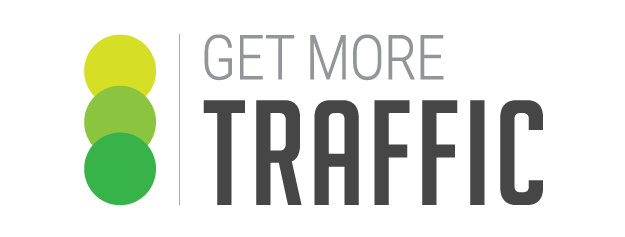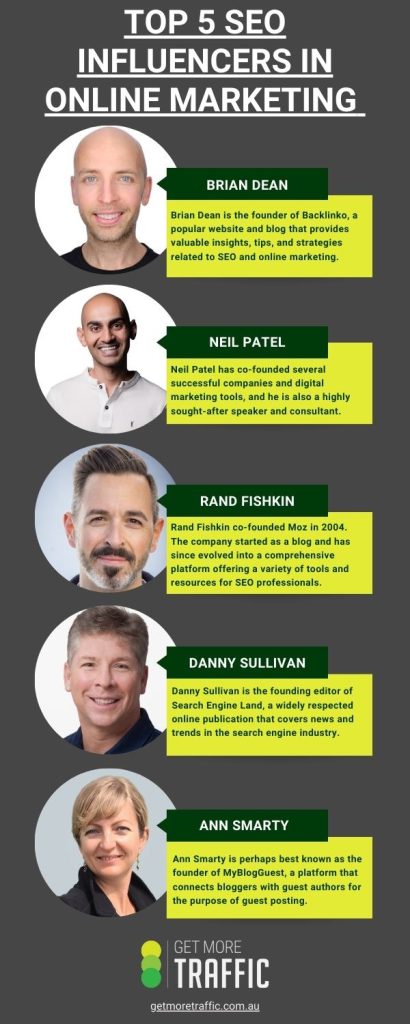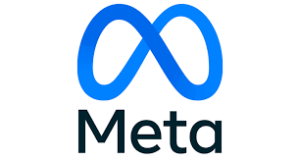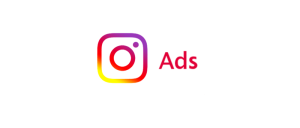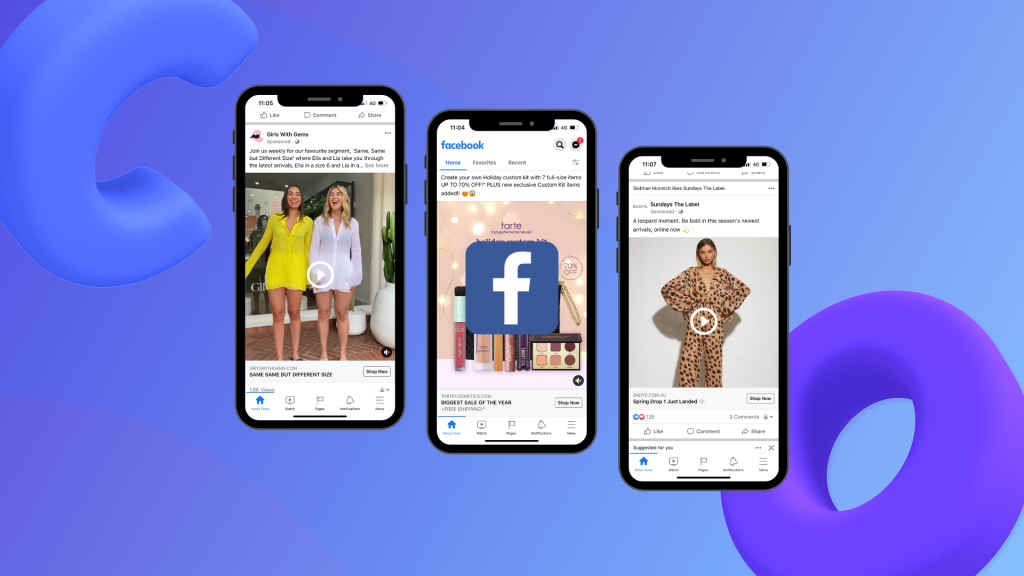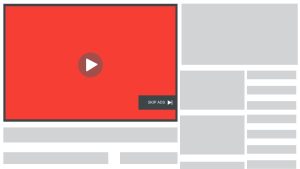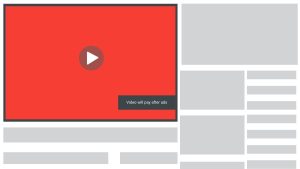Top Five SEO Influencers in 2023
As businesses strive to enhance their digital presence and climb the ranks of search engine results, the guidance and expertise of SEO influencers have become invaluable. In this article, we delve into the realm of online marketing to present you with a curated list of the top five SEO influencers who are shaping the way we understand and implement SEO strategies. From thought-provoking insights to innovative techniques, these influencers have earned their place at the forefront of the SEO sphere, providing actionable advice that can transform your digital endeavors.
1. Brian Dean
Brian Dean is the founder of Backlinko, a popular website and blog that provides valuable insights, tips, and strategies related to SEO and online marketing. He gained a significant following by sharing in-depth and actionable guides on topics such as link building, on-page SEO, content creation, and more.
One of Brian Dean’s most famous concepts is the “Skyscraper Technique,” a content creation and link-building strategy that involves finding existing popular content, creating something even better, and then reaching out to relevant websites to gain backlinks. This technique has been widely adopted by marketers and SEO professionals as an effective way to improve a website’s search engine rankings.
Brian Dean Profiles:
Brian Dean Courses:
2. Neil Patel
Neil Patel has co-founded several successful companies and digital marketing tools, and he is also a highly sought-after speaker and consultant. He has co-founded companies like Crazy Egg, Hello Bar, and Kissmetrics, which offer various analytics and conversion optimization tools for websites. These tools have been used by many businesses to improve their online presence and user experience. He is known for creating extensive and informative content on his blog and YouTube channel. His content aims to help both beginners and experienced marketers understand and implement effective online marketing strategies.
Neil Patel Profiles:
Neil Patel Courses:
3. Rand Fishkin
Rand Fishkin co-founded Moz in 2004. The company started as a blog and has since evolved into a comprehensive platform offering a variety of tools and resources for SEO professionals, marketers, and website owners. After leaving Moz, Rand Fishkin co-founded SparkToro, a company that provides audience intelligence tools. SparkToro helps marketers and businesses understand their target audiences better, discover where they hang out online, and make data-informed decisions about marketing strategies.
Rand Fishkin Profiles:
Rand Fishkin Courses:
4. Danny Sullivan
Danny Sullivan is the founding editor of Search Engine Land, a widely respected online publication that covers news, trends, and developments in the search engine industry. Search Engine Land provides valuable insights and updates related to search engine algorithms, search marketing, SEO, and paid search advertising. Before founding Search Engine Land, Danny Sullivan was involved with other prominent publications and events in the search industry. He was a co-founder of Search Engine Watch and was closely associated with the Search Engine Strategies (SES) conference series.
Danny Sullivan Profiles:
Danny Sullivan Courses:
5. Ann Smarty
Ann Smarty is perhaps best known as the founder of MyBlogGuest, a platform that connects bloggers with guest authors for the purpose of guest posting. Guest posting is a common practice in SEO where writers contribute content to other websites in exchange for exposure and backlinks. MyBlogGuest aimed to facilitate this process and help bloggers connect for mutual benefit. She also worked as the Content Director at Internet Marketing Ninjas (now known as NinjaCat), an online marketing agency. In this role, she contributed to the agency’s content marketing efforts and provided valuable insights to clients.
Ann Smarty Author Profiles:
Ann Smarty Courses:
Infographics:
Complete Branding Guide for Tradies | Make Your Brand Professional
Understanding Branding for Tradies:
Branding for tradies refers to the strategic process of creating and managing a unique and cohesive identity for businesses and professionals in the skilled trades industry. It goes beyond just designing logos and choosing colors; instead, it involves shaping the perception of the business in the minds of potential and existing customers. Branding is a comprehensive approach that encompasses visual elements, brand messaging, customer experience, and the overall reputation of the tradie business.
What is branding for tradies and why is it important?
Branding is the sum of all the experiences, emotions, and associations that customers have with a tradie business. It represents the business’s personality, values, and promise to customers. In the trades industry, where competition can be fierce, branding becomes a vital tool for tradies to stand out from the crowd and establish a strong presence in the market.
A well-executed branding strategy can help tradies:
- Build Trust and Credibility: A consistent and professional brand image fosters trust among potential customers, as it indicates reliability and competence in delivering services.
- Attract and Retain Customers: A strong brand identity helps tradies attract new customers and also fosters loyalty among existing ones, leading to repeat business and word-of-mouth referrals.
- Command Premium Pricing: A reputable brand allows tradies to justify premium pricing for their services, as customers are willing to pay more for perceived value and quality.
- Increase Business Value: A well-established brand enhances the overall value of the tradie business, making it a valuable asset in case of future expansion or sale.
- Establish a Memorable Identity: A distinctive brand identity creates a lasting impression on customers, making it easier for them to remember and recommend the tradie’s services.
The benefits of a strong brand in the trades industry:
In the competitive trades industry, a strong brand confers several advantages to tradies
- Competitive Advantage: A well-defined brand helps tradies differentiate themselves from competitors who may offer similar services. It allows tradies to communicate their unique strengths and value propositions clearly.
- Customer Loyalty: A strong brand creates an emotional connection with customers, fostering loyalty and repeat business. Satisfied customers are more likely to choose the same tradie for future projects.
- Enhanced Professionalism: A consistent brand image signals professionalism and reliability, influencing potential customers to perceive the tradie business as more established and trustworthy.
- Confidence in Marketing: With a strong brand identity, tradies can market their services with confidence, knowing that their message is consistent and impactful.
- Business Expansion Opportunities: A reputable brand opens doors to potential partnerships, collaborations, and expansion opportunities in the industry.
Branding for Tradie Startups:
For tradie startups, branding is a critical foundation that sets the tone for their business’s growth and success. Building a strong brand identity from the beginning helps startups establish themselves in the market and create a positive first impression with customers. Startups need to invest time in understanding their target audience, industry landscape, and competitive advantages to craft a brand that resonates with their potential customers.
Branding for Existing Brands:
Established tradie businesses can benefit from branding efforts by refining their existing brand identity and staying relevant in a changing market. Rebranding or updating the brand can be a strategic move to revitalize the business, attract new customers, and reinforce their market position. Existing brands must assess their current brand perception, customer feedback, and market trends to make informed decisions about evolving their brand while maintaining brand equity.
Developing a Brand Identity:
Developing a strong brand identity is a crucial aspect of successful branding for tradies. It involves carefully crafting the visual and verbal elements that will represent the essence of the business and resonate with the target audience. A well-defined brand identity not only sets the tradie business apart from competitors but also communicates its values, personality, and professionalism. Here’s an expanded explanation of the key components involved in developing a brand identity:
Creating a Unique Brand Name and Logo:
The brand name is the foundation of the tradie’s identity. It should be distinctive, memorable, and relevant to the business. When choosing a brand name, tradies should consider factors like simplicity, availability of domain names, and potential trademark conflicts. A well-thought-out logo, on the other hand, visually symbolizes the brand and serves as its recognizable face. The logo should be designed to reflect the nature of the business and leave a lasting impression on customers.
Choosing Brand Colors and Typography:
Colors play a significant role in brand identity, as they evoke emotions and associations. Tradies should carefully select a color palette that aligns with their brand personality and appeals to their target audience. For example, bold and vibrant colors might be suitable for a construction company, while softer and earthy tones could work well for a landscaping business. Typography, the choice of fonts and how they are used, also contributes to the overall brand aesthetics and should be consistent with the brand’s style.
Crafting a Brand Tagline or Slogan:
A brand tagline or slogan is a short and memorable phrase that encapsulates the essence of the tradie business. It should convey the unique value proposition, core message, or mission of the brand in a concise and impactful way. A well-crafted tagline can become a powerful tool in reinforcing the brand’s identity and leaving a lasting impression on customers. For instance, a plumbing business might use a tagline like “Your Pipes, Our Expertise,” emphasizing their commitment to providing top-notch plumbing services.
The process of developing a brand identity requires careful research and understanding of the target market, competition, and the unique strengths of the tradie business. It is essential to maintain consistency across all brand elements to ensure a cohesive and recognizable brand presence. Once the brand identity is established, it can be applied to various aspects of the business, including marketing materials, website design, uniforms, and even the appearance of company vehicles. A strong and consistent brand identity builds trust and credibility with customers, making them more likely to choose the tradie’s services over others in the market.
Defining Your Brand Personality:
Identifying and defining your brand’s personality traits:
Tradies need to identify the personality traits that best represent their brand. This involves understanding the core values of the business, its mission, and what it wants to be known for in the market. Some common brand personality traits include:
- Reliable: Emphasizing consistency and dependability in delivering high-quality services.
- Friendly: Portraying approachability and warmth in customer interactions.
- Professional: Conveying expertise and competence in the trade industry.
- Innovative: Highlighting a forward-thinking and creative approach to problem-solving.
- Trustworthy: Building trust and credibility by being honest and transparent with customers.
Aligning the brand personality with the target audience:
To create a strong brand connection, tradies must understand their target audience’s preferences, needs, and values. By aligning the brand personality with the target audience, the brand becomes more appealing and relatable.
Here are some steps defining your brand personality:
- Determine your brand’s target audience
- Identify your brand archetype mix
- Identify your brand’s values
- Define your brand’s voice
- Create a visual identity
- Communicate consistently
Adding to this, Market research and customer feedback play a crucial role in gaining insights into the target audience’s perceptions and expectations. With a deep understanding of the audience, tradies can tailor their brand messaging and communication to resonate with potential customers.
Maintaining consistency in brand messaging:
Consistency is key to establishing a strong brand personality. Tradies must ensure that the brand’s personality traits are consistently communicated across all brand touchpoints, including marketing materials, website, social media, and customer interactions. Inconsistent messaging can confuse customers and dilute the brand’s identity.
Brand guidelines can help maintain consistency by providing clear instructions on how to use brand elements, colors, and language. These guidelines should be followed by all team members and stakeholders involved in representing the brand. Consistency in brand messaging reinforces the brand’s personality, making it easier for customers to recognize and connect with the brand across various platforms.
Brand Messaging and Communication:
Crafting a compelling brand story:
A brand story is a narrative that communicates the tradie business’s history, mission, values, and journey. It humanizes the brand, making it more relatable to customers. The brand story should be authentic, engaging, and emotionally compelling. It can include the challenges the tradie business overcame, its passion for the trade, and the positive impact it seeks to create for its customers. A well-crafted brand story helps customers connect with the brand on a deeper level and understand the purpose behind the tradie business.
Developing key brand messages and value propositions:
Key brand messages are the core statements and phrases that succinctly communicate the brand’s unique selling points and benefits to the customers. These messages should be clear, concise, and tailored to the needs and pain points of the target audience. Value propositions are statements that explain the value customers can expect to receive from the tradie’s services. They emphasize the benefits, quality, and advantages that set the business apart from competitors. Strong and compelling brand messages and value propositions help differentiate the tradie business and leave a lasting impression on customers.
Effective communication channels for tradies’ branding:
- Social media platforms: Social media platforms like Facebook ads and Google Ads offer opportunities to engage with the target audience, share brand stories, showcase projects, and respond to customer inquiries.
- Email Marketing and Newsletter Campaigns: Building an email list allows tradies to communicate directly with their audience, share updates, promotions, and valuable content.
- Content Marketing Strategies: Content marketing allows tradies to showcase their expertise and build trust with their audience. We’ll discuss the importance of creating valuable and informative content and strategies for content creation and distribution.
- Online Reviews and Reputation Management: This will explore the significance of online reviews, techniques for generating positive reviews, and strategies for reputation management.
- Blogging: Publishing informative and valuable content on a blog can establish the tradie business as an authority in the industry and attract potential customers.
Building an Online Presence:
Establishing a professional website for your tradie business:
A professional website serves as the online hub for the tradie business. It is essential to create a user-friendly and visually appealing website that reflects the brand’s identity and values. The website should include important information such as services offered, contact details, a portfolio showcasing previous projects, customer testimonials, and the brand story. Additionally, it should be optimized for mobile devices to ensure a seamless browsing experience for users on smartphones and tablets.
Leveraging social media for brand promotion:
Social media platforms offer powerful tools for brand promotion and engagement with the target audience. Tradies should identify the social media channels that are most relevant to their industry and where their target customers are active. They can use platforms like Facebook, Instagram, Pinterest, or Twitter to share updates, project photos, videos, and helpful tips related to their trade. Consistent posting and engaging with followers can help build brand awareness, foster community, and attract potential customers.
Utilising online platforms to showcase work and expertise
Online platforms dedicated to showcasing work and expertise can be highly valuable for tradies. For instance:
- Online Portfolios: Creating an online portfolio allows tradies to display images and descriptions of completed projects. This showcases their skills and capabilities to potential customers.
- Home Improvement Websites: Listing on home improvement websites, directories, or platforms like Houzz and HomeAdvisor can increase the tradie business’s visibility and attract leads from customers actively seeking services.
- Video Platforms: Utilizing video platforms like YouTube or Vimeo to share tutorials, project walkthroughs, and behind-the-scenes content can demonstrate expertise and engage with the audience.
- Online Forums and Q&A Platforms: Engaging in relevant online forums and Q&A platforms can establish the tradie as an authority in their field and provide valuable advice to potential customers.
Customer Experience and Brand Perception:
Creating a positive customer experience at every touchpoint:
To create a positive customer experience, tradies must prioritize customer satisfaction and strive to exceed expectations at every touchpoint which involves the following points:
- Prompt and Responsive Communication: Responding to customer inquiries and requests in a timely and courteous manner demonstrates professionalism and attentiveness.
- Clear and Transparent Pricing: Providing transparent pricing and estimates helps build trust with customers and avoids any misunderstandings later on.
- Professional and Courteous Service: Treating customers with respect and courtesy throughout the entire process leaves a lasting impression and contributes to a positive brand perception.
- High-Quality Workmanship: Delivering high-quality work that meets or exceeds customer expectations is crucial for building trust and earning repeat business.
- After-Sales Support: Following up with customers after completing a project to ensure their satisfaction shows that the tradie values their feedback and cares about their experience.
- Resolving Issues Promptly: Addressing any customer concerns or complaints promptly and effectively helps turn negative experiences into positive ones.
Encouraging customer reviews and testimonials:
Positive customer reviews and testimonials are valuable assets for brand perception. They serve as social proof of the tradie’s expertise and the quality of their services. To encourage customer reviews and testimonials:
- Request Feedback: After completing a project, ask customers for feedback on their experience and if they would be willing to provide a review or testimonial.
- Make it Easy: Provide customers with user-friendly platforms or forms where they can leave reviews or share their thoughts.
- Incentives: Consider offering incentives, such as discounts to customers who take the time to leave a review.
- Showcase Reviews: Display customer reviews and testimonials prominently on the website, social media, and marketing materials to build trust with potential customers.
Monitoring and managing brand reputation:
Brand reputation is the overall perception that customers, industry peers, and the public have about the tradie business. To maintain a positive brand reputation:
- Monitor Online Presence: Regularly monitor online reviews, social media mentions, and comments to address any negative feedback or reviews promptly.
- Respond to Feedback: Respond to both positive and negative feedback in a professional and courteous manner, showing that the tradie values customer opinions and is committed to improvement.
- Address Negative Reviews: Address negative reviews or complaints constructively, and take necessary steps to rectify any issues raised.
- Showcase Positive Feedback: Share positive feedback and testimonials on various platforms to reinforce the brand’s positive reputation.
- Stay Authentic: Be genuine and authentic in interactions with customers and stakeholders to build a trustworthy and positive brand image.
Incorporating Branding in Marketing Strategies:
Integrating branding into traditional marketing efforts:
Traditional marketing methods remain relevant and effective for tradies, especially in local markets. By integrating branding into traditional marketing efforts, tradies can reinforce their brand image and increase brand recognition. Here are some reasons why traditional marketing helps in branding:
- Tangible and Credible Presence: Traditional marketing channels, such as print advertisements and direct mail, offer a physical presence that consumers can see, touch, and experience. This tangibility lends credibility to the brand and its messaging, creating a lasting impression on the audience. For example, a well-designed print ad in a reputable magazine can convey a sense of quality and legitimacy to the right audience.
- Broad Audience Reach: Traditional marketing channels often have a wide and diverse audience reach. Television and radio advertisements, for instance, can reach a large number of viewers or listeners simultaneously. This mass reach is particularly beneficial for businesses targeting a broad demographic or seeking to generate widespread awareness.
- Local Targeting: Traditional marketing channels allow for effective targeting of local audiences. Local newspapers, radio stations, and billboards can be utilized to specifically reach consumers within a particular geographic area. This is especially valuable for small businesses or those operating in niche markets that benefit from localized advertising efforts.
- Establishing Authority and Trust: Traditional marketing channels, such as print publications or television appearances, provide an avenue for businesses to position themselves as experts in their field. Being featured in respected industry publications, participating in radio or TV interviews, or publishing articles in print media can enhance a company’s credibility and establish authority within the market.
- Targeting Specific Demographics: Traditional marketing channels can effectively reach specific demographic segments. Magazines, for example, often cater to niche interests, allowing businesses to target a particular demographic that aligns with their products or services. This targeted approach helps ensure that marketing messages reach the intended audience.
- Emotional Impact: Traditional marketing channels have the ability to evoke emotional responses in ways that digital channels may struggle to replicate. A well-crafted TV commercial, for example, can engage viewers or readers on a deeper emotional level, leaving a lasting impression. This emotional impact can be powerful in influencing consumer behavior and fostering brand loyalty.
- Offline Consumer Behavior: While the digital landscape has significantly altered consumer behavior, offline activities still play a crucial role in the customer journey. Traditional marketing channels can influence and drive consumers to take action in physical stores, events, or other offline touchpoints. For example, a print ad featuring a limited-time offer can prompt consumers to visit a store and make a purchase.
Utilising branding in online marketing campaigns:
Online marketing is an integral part of modern marketing strategies for tradies. Leveraging branding elements in online campaigns helps create a cohesive online presence and reinforces the brand’s identity. Some ways to utilise branding in online marketing campaigns include:
- Website Design: Ensure that the website design aligns with the brand’s visual identity, including the logo, colors, and typography. The website should reflect the brand’s personality and showcase its services effectively.
- Social Media: Consistently use branded visuals and messaging across all social media platforms. Engage with followers in a way that reflects the brand’s personality and values.
- Email Marketing: Incorporate branding elements in email templates and newsletters to create a professional and recognizable brand presence in customers’ inboxes.
- Google Ads: Use consistent branding in online advertising campaigns, including Google display ads, Google search ads, Google shopping ads and other pay-per-click (PPC) platforms like Microsoft ads, to reinforce brand recognition and trust.
Leveraging branding for word-of-mouth referrals:
Word-of-mouth referrals are powerful for tradies, as they often come from satisfied customers and carry significant credibility. By leveraging branding effectively, tradies can encourage positive word-of-mouth referrals and strengthen their brand reputation. Some strategies for leveraging branding for word-of-mouth referrals include:
- Consistent Service Quality: Deliver exceptional service consistently to every customer, aligning with the brand promise. Satisfied customers are more likely to recommend the tradie business to others.
- Customer Testimonials: Encourage satisfied customers to provide testimonials that highlight their positive experiences with the brand. Display these testimonials on the website and social media to build trust with potential customers.
- Referral Programs: Implement a referral program that rewards customers for referring others to the tradie business. Offering incentives like discounts or gift cards can motivate customers to spread the word.
- Personalized Follow-ups: After completing a project, follow up with customers to ensure their satisfaction and thank them for their business. Personalized gestures can leave a lasting impression.
Branding Collateral for Tradies:
Branding collateral refers to the various materials and assets that carry a tradie business’s brand identity and messaging. These materials play a crucial role in reinforcing the brand and creating a consistent brand experience for customers. Here are some common types of branding collateral for tradies:
Types of Branding Collateral:
- Logo Design
- Branding Packs
- Business Cards
- Signs
- Stationary
- Templates
- Flyers and Brochures
- Company Profiles
- Stickers
- Magnets
- Websites
- Advertising
Branding and Professionalism:
How branding enhances the perception of professionalism:
- Establishing a Strong Identity: A well-defined brand identity, including a professional logo, brand colors, and cohesive visual elements, creates a distinct and memorable brand image. This distinct identity sets the tradie business apart from competitors and portrays a sense of professionalism.
- Building Trust and Credibility: Consistent branding signals reliability and consistency in service delivery. Customers are more likely to trust a tradie business with a strong and professional brand identity, as it conveys a commitment to maintaining high standards.
- Reflecting Expertise and Specialization: Branding can emphasize the tradie’s expertise and specialization in a particular field. This specialization enhances the perception of professionalism as customers are more likely to trust a business that demonstrates in-depth knowledge and experience in their area of expertise.
- Consistency Across Touchpoints: A consistent brand experience across all touchpoints, including the website, social media, marketing materials, and customer interactions, reinforces the professionalism of the tradie business. A unified brand message and appearance leave a lasting impression on customers.
The importance of clear communication and presentation:
- Clear Messaging: Effective branding ensures that the brand’s messaging is clear, concise, and targeted to the audience. By communicating the value, benefits, and unique selling propositions clearly, the tradie business can effectively convey its professionalism and the benefits of its services to potential customers.
- Professional Presentation: Branding extends beyond the visual elements to encompass the overall presentation and conduct of the business. This includes the appearance and behavior of employees, how phone calls are answered, email communication, and the overall customer service experience. A professional presentation demonstrates the tradie’s commitment to professionalism and attention to detail.
- Brand Consistency: Clear and consistent branding across all communication channels reinforces the professionalism of the tradie business. Whether it’s a business card, website, or social media post, maintaining consistent branding elements helps customers recognize and trust the brand.
Delivering consistent service quality to reinforce the brand:
- Brand Promise: A well-defined brand promise sets customer expectations for the level of service they can expect. Delivering on this promise consistently reinforces the brand’s professionalism and builds trust with customers.
- Training and Development: Investing in the training and development of employees ensures that they have the necessary skills and knowledge to deliver high-quality service consistently. A competent and skilled team contributes to the perception of professionalism.
- Customer Feedback: Listening to customer feedback and continuously improving service based on customer insights is crucial for maintaining consistent service quality. Positive customer experiences lead to positive word-of-mouth referrals, further reinforcing the brand’s professionalism.
Evaluating and Evolving Your Brand:
Measuring the effectiveness of branding efforts:
To determine how effective branding efforts are, tradies can use various metrics and key performance indicators (KPIs). Some important metrics to consider include:
- Brand Awareness: Assessing the level of brand recognition and recall among the target audience, both through quantitative data and surveys.
- Customer Perception: Gathering feedback from customers to understand how they perceive the brand and whether it aligns with the intended brand identity.
- Customer Engagement: Measuring customer interactions with the brand, such as website visits, social media interactions, and email open rates.
- Return on Investment (ROI): Evaluating the impact of branding efforts on business growth and revenue generation.
- Conversion Rates: Tracking how well branding efforts lead to customer conversions and new business opportunities.
Collecting feedback from customers and making improvements:
Customer feedback is invaluable for understanding how the brand is perceived and what aspects need improvement. Tradies can collect feedback through various channels, including:
- Customer Surveys: Conducting surveys to gauge customer satisfaction, preferences, and perceptions of the brand.
- Online Reviews and Testimonials: Monitoring online reviews and testimonials to identify areas of strength and areas for improvement.
- Customer Support Interaction: Actively listening to customer inquiries, complaints, and feedback during customer support interactions.
- Social Media Listening: Monitoring social media platforms for mentions and comments related to the brand.
Adapting the brand to changing market trends:
We live in an unstable environment where everything is constantly changing. That means what we consider a must-buy one week could be consigned to the trash heap of cultural history the next. So how can your business stay competitive and relevant?
- Market Research: Conducting regular market research to identify emerging trends, customer needs, and competitor strategies.
- Brand Refresh: Periodically refreshing the brand’s visual identity or messaging to keep it current and reflective of evolving market demands.
- Embracing Innovation: Integrating new technologies or service offerings that align with market trends and cater to customer preferences.
- Flexibility in Communication: Being adaptable in communication channels to meet customers where they are, such as embracing new social media platforms or marketing channels.
Branding is essential for creating a lasting impression on customers and standing out in a crowded market. Integrating branding in marketing strategies, both traditional and online, further enhances brand perception and helps build a professional image. By delivering consistent service quality and seeking customer feedback, tradies can continuously evolve their brand, adapt to changing market trends, and maintain a strong brand reputation, leading to long-term success and growth.
FAQS Branding for Tradies:
Why is branding important for tradies, and how can it benefit my business?
This question seeks to understand the significance of branding specifically for tradespeople and how it can positively impact their business. Tradies may wonder how investing time and resources into branding efforts can help them stand out in their industry and attract more customers.
How do I create a strong brand identity as a tradie, and where do I start?
Tradies often want guidance on how to develop a distinctive brand identity that reflects their skills, values, and unique selling propositions. This question aims to learn the essential steps and components involved in crafting a strong brand identity, such as creating a logo, choosing colors, defining brand personality, and maintaining consistency.
Can branding really make a difference for my small tradie business, or is it only for larger companies?
Some tradies may have concerns about the relevance and impact of branding, especially if they run small businesses or work independently. This question seeks to clarify whether branding is equally essential for businesses of all sizes and if it can help small tradie businesses compete effectively in the market.
Online reputation management for Doctors
Online reputation management for doctors is a crucial aspect of maintaining a positive image and building trust with patients.
Read More: Online Marketing Services for Doctors
Tasks for Online Reputation Management for Doctors
1. Monitoring Online Presence: Online reputation management begins with monitoring your online presence. This involves regularly monitoring various platforms such as search engine results, review websites, social media channels, and healthcare directories. By actively monitoring these platforms, you can stay informed about what patients are saying about your practice and quickly address any negative feedback or inaccuracies.
2. Responding to Patient Reviews: Patient reviews play a significant role in shaping your online reputation. It’s important to actively engage with patient reviews, both positive and negative. Responding to positive reviews shows appreciation and reinforces a positive perception of your practice. Addressing negative reviews promptly and professionally demonstrates your commitment to patient satisfaction and can help mitigate any potential damage to your reputation.
3. Managing Social Media Profiles: Social media platforms provide an avenue for patients to engage with your practice. Regularly updating and managing your social media profiles allows you to present an accurate and positive image. Share relevant content, respond to patient inquiries or comments, and showcase your expertise to build trust and engage with your audience.
4. Optimizing Website Content: Your practice website is a vital component of your online reputation. Ensure that your website accurately represents your services, qualifications, and values. Optimize the content to improve search engine visibility, making it easier for patients to find you online. Regularly updating your website with fresh and informative content helps establish your authority in the medical field.
5. Addressing Inaccuracies: Inaccurate information about your practice can harm your online reputation. It’s essential to regularly audit online directories, review websites, and healthcare listings to ensure that your contact details, practice hours, and services are accurate. Correct any inaccuracies promptly to avoid confusion and provide accurate information to potential patients.
6. Encouraging Positive Feedback: Actively encouraging satisfied patients to leave positive reviews can boost your online reputation. Consider implementing strategies such as requesting feedback after appointments, providing a user-friendly process for leaving reviews, or sending follow-up emails to thank patients and encourage them to share their experiences online. Positive reviews can help counterbalance any negative feedback and enhance your overall reputation.
7. Seeking Professional Assistance: Managing your online reputation can be time-consuming, especially when you need to focus on providing excellent patient care. Consider partnering with a reputable online reputation management service or agency specializing in healthcare. These professionals can help monitor your online presence, respond to reviews, address inaccuracies, and implement strategies to enhance your online reputation effectively.
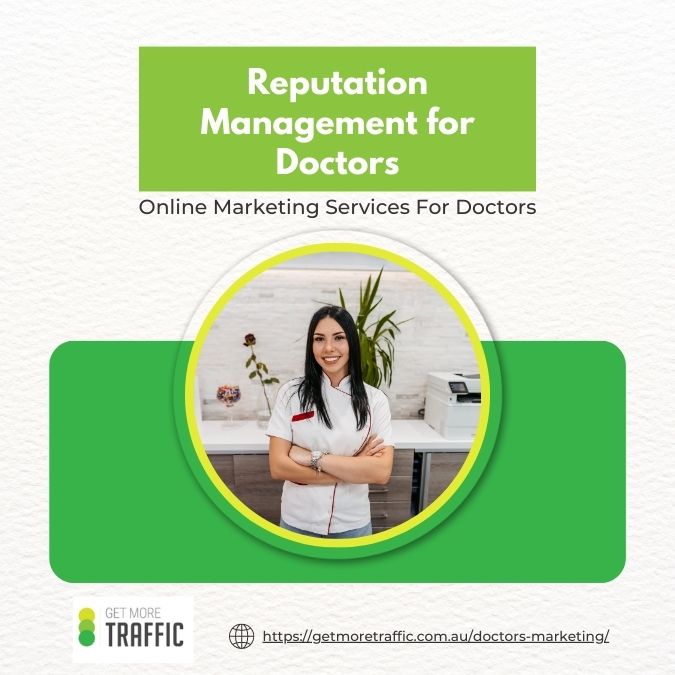
By proactively managing your online reputation, you can maintain a positive image, build patient trust, and attract new patients to your practice. It’s an ongoing process that requires attentiveness, responsiveness, and a commitment to providing exceptional patient experiences both offline and online.
What is Keyword Difficulty and how does it affect your rankings?
Keyword difficulty refers to the metric used to measure the amount of effort it would take for content to rank first on search engines for a certain keyword. The higher the keyword difficulty, the more time and effort is needed for you to achieve the desired result.
Does that mean, then, that it’s better to go after keywords that are less difficult?
The truth is not as simple. While difficult keywords do require more effort, oftentimes that effort proves to be worth it. As you plan out your content strategy, make sure that you choose which keywords to target based on both keyword difficulty and search volume. Balance is key when planning out a long-term content strategy.
How Do You Determine Keyword Difficulty?
There are a couple of factors that are considered when determining keyword difficulty. These include:
- Competition
- Domain Authority
- Search Intent
- Content Quality
- Backlink Quality
Let’s go through them one by one.
Competition
When it comes to competition in SEO, there are different types of competitors that you have to take into account: industry competitors (or other companies within the same industry, selling similar products and services) and keyword competitors (which include those who are currently ranking for those keywords, as well as other domains that are creating content for a similar audience).
When considering keyword difficulty you have to take into account just how many people are also trying to rank for that particular keyword. The greater the competition, the greater the difficulty.
Scope out the competition and what kind of content it is they’re writing, and then you can figure out how you can create content that both serves your audience and differentiates yourself from them.
Domain Authority
Building authority online takes a lot of time and effort, especially when your competition is already well-established on search engine ranking pages (SERPs). Tools like SEMRush can help you evaluate where you stand in terms of domain authority, but building authoritative content that increases your score will largely depend on your content strategy.
Domain authority is based on two things: your own authority and your competition’s authority.
If your website is fairly new as compared to your competition (which might be well-established) this brings keyword difficulty to higher levels. It’s an uphill battle to prove to search engines that your content is better than those already ranking at the top spot.
Search Intent
As you’re building your authority, always consider if your content is actually getting clicks and if those clicks result in a higher average time spent on page. You want to make sure that people are actually reading your content. Sometimes low metrics only means that the keyword just isn’t suited for the type of content you’ve published.
The easiest way to evaluate search intent is to type your keyword onto Google and look at what types of content appear in the results. Are they similar to, or aligned with the intent behind your content? Or are they vastly different?
Content Quality
It’s all about quality content. But what is content quality, and how is it determined?
Quality content includes many of the factors mentioned previously. A piece of content should be receiving enough clicks and read for Google to consider it authoritative.
Quality content usually covers a topic in-depth. In fact, many content marketers have attested that long-form content consisting of 3,000 words or more receives more traffic, shares, and backlinks than content that consists of only 1,000 words or less.
Quality content, of course, is also free of grammatical errors and shows a native-level command of the language.
Most of all content quality is determined by the practical value it’s able to give readers. What will your readers take away from reading your blog post or article? Will they come out more informed, enlightened, and empowered? These are some things to consider when creating quality content.
Backlink Quality
Like social shares, backlinks are a good metric to show whether a piece of content is helpful, relevant, and authoritative. However, not all backlinks are equal.
Quality backlinks are those that come from authoritative sources. Backlinks such as these signal to Google that your site is trustworthy and helps build your domain authority.
What that means for keyword difficulty, then, is that if your competitors have strong backlink profiles then it becomes increasingly difficult to try and rank for those same keywords. You can still continue at working on building your own authority over time even as your competitors build theirs.
Ranking for difficult keywords can be taxing and time consuming. And oftentimes business owners don’t have the time and energy to be able to build long term content strategies to suit their SEO needs. But that’s where Get More Traffic can lend a hand. If you’re looking for a partner to help you build your domain authority and rank for difficult keywords, contact the team at Get More Traffic today!
How Tradies Can Increase Bookings This Easter
Increasing Your Bookings Over Easter: Advice For Tradies
Do you hear that? It’s Easter, and it’s fast approaching. Don’t panic, though, because we have some tradies marketing advice to help you increase your bookings these Easter holidays. So without any further adieu, let’s cruise right into it.
Advertising For Tradies: The Importance Of Switching Up Your Ads
The truth is, clients know when you’ve done your homework. If you still have your St Pattie’s ads running over Easter, well, then that’s a bit of a problem. Not only does incorrect advertising show potential clients you’re unprepared, but it can reflect poorly on your entire business. ‘If they can’t even update their website, how can I trust them to provide a professional service?’. And look, we know how dramatic that sounds. But, when it comes to beating out the competition, you’ve really got to do all you can to come out on top. So, how do you do that? Well, let us give you some pointers.
Tips For Overtaking The Competition This Easter Period
If you’re keen to fill your books over the Easter holidays, here are some tips to give you a jumpstart:
Get into the spirit. Change your ads to reflect the Easter season. This could look like Easter imagery or some egg-cellent puns sure to capture your audience’s attention.
Promotions/seasonal pricing. You want to start your promotions and offers a little early to ensure that clients know you’re available if your services are needed over Easter. Your ads might look something like: ‘We’re open all of Easter, and because we understand accidents happen, we’re offering our services to clients 24/7.’ ‘Refer a friend this Easter, and we’ll waive your call out fee. That’s our holiday guarantee!’
Use your social media. Engage and communicate with your audience through your social media stories, statuses, and posts. This is not only a great way to strengthen ongoing client/tradesman relationships but is an opportunity to widen your reach.
Implement hashtags. Hashtags don’t need to go viral to make an impact. So making business-specific hashtags you can use over Easter can help increase traffic to your page/s.
Pop-Ups and banners. What better way to increase traffic than through an eye-catching pop-up or banner? No, we don’t mean those annoying ones that clog up your page and deter audiences from engaging. We mean holiday specific banners that are a quick and effective way to relay information to your customers. Like the one below!
Do your research! Finally, look into what your competitors offer and try to do one better. If your competitor is closed over the break, that’s great, but you want to find the best way to come out on top if they aren’t. So, research around to optimise your booking potential.
How Digital Marketing For Tradies Can Help Drive Traffic And Leads To Your Business
Raise your hand if you have a phone on you or within reach. Everybody? Okay, cool. Raise your hand if you have either made a call or sent an email on that phone. Exactly! Most people have. Digital marketing helps put your business at the fingertips of consumers. Here’s how it can help you:
Consistent online presence. Regularly promoting your company on all platforms will help increase your organic reach. This could look like status uploads, images of your work or replies to your reviews.
Local business directories. We can’t say it any louder: PROMOTE, PROMOTE, PROMOTE. And this one is simple because it requires little effort and maintenance. Fact is, the world is going digital, and consumers want businesses to be more accessible than ever. So, start with Google My Business and then get listed other directories like hipages and Tradif so customers can find you when they need you.
Search Engine Optimisation or SEO. Do you have specific keywords you’d like to appear on Google for? Good news because that’s where SEO comes in. Optimising your website for SEO purposes helps you rank higher on Google. So this Easter, try changing up your website copy to reflect your holiday booking needs.
Facebook Ads. Did you know that consumers use their phones more during the holidays? It’s no wonder either; they don’t have jobs to attend! You can take advantage of this, though, and set up ads on Facebook to reach a larger target market.
Google Ads. A common misconception is that tradies should pause their ads over the holidays. However, during this time, your ads are more important than ever. Plus, if everyone else is pausing theirs, you’ll come out on top. So really, you are the real winner here.
For more information about tradies marketing or to increase your reach these holidays, get in touch with our team of digital marketers today.
Make The Most Out Of Your Digital Marketing With The Specialists At Get More Traffic
Is your website a highway at peak hour? Because boy, you’ll be getting a lot of traffic with the help of our digital marketing experts. We’re passionate about helping businesses all over Australia harness the power of digital marketing to take their bookings to the next level. So, if you’re ready to give traffic to your website the green light and learn more about tradies marketing, contact the team at Get More Traffic today!
SEO Tips For Local Contractors And Tradies
Getting a first-page Google ranking shouldn’t be a struggle, but if you’re unsure how the whole process works, you might encounter some difficulties. Here at Get More Traffic, we work closely with businesses to help improve their online presence, increase traffic and leads to their websites, and see results in sustainable and quality growth. At Get More Traffic, we often work with contractors from across Australia and New Zealand looking to increase leads through Google Ads and search engine optimisation (SEO). So, to get you started, we’ve developed the ultimate guide to contractor SEO and chock-filled it full of useful tips and tricks to get you on your way to becoming an SEO superstar with a front-page google ranking.
So Then, What Is Contractor SEO?
In short, SEO for contractors involves improving (or sometimes making from scratch) websites to move up their Google ranking. It is essentially an online promotion of your business using marketing strategies on-page and off-page (a process known as backlinking). But it’s more than just going through and tidying up your website. SEO specialists will use specific marketing techniques and spread keywords or keyphrases throughout your website to help Google quickly identify what you’re promoting or advertising to your consumers. Alright, but how will this help me as a contractor bring traffic to my website? We are so glad you asked. Jump to the next paragraph to find out.
How SEO Can Help Contractors Increase Traffic To Their Website
Implementing SEO strategies builds trust with Google. Google is more intelligent than most people realise, and if your site feels incredible, the search engine will leave it behind. Techniques like backlinking and strategic keyword use tell Google’s crawlers that you’re reliable and here to stay.
Helps keep you competitive. Have you ever trusted a contractor you found on the second, third, fourth, or even fifth page of Google? Better yet, have you ever ventured to any of those pages, or do you stick with the first page results? If you answered yes to the latter, then you’re among the majority of Google users. Implementing SEO strategies to your website helps you get seen by more consumers and results in additional traffic and conversions.
Gives your company a longer shelf life. Traffic tends to slow after a campaign is over, but keeping on top of your SEO strategies keeps it relevant and accessible.
SEO brings the clients to you. In the long term, SEO helps consumers come to you. Gone are the days of letter dropping or advertising in the newspaper or yellow pages. Instead, optimise your website and have your next client come right to you.
10 Tips To Assist Contractors With Search Engine Optimisation
- Keep it local with Google My Business. Google My Business (GMB) is a great resource to help you become more visible and credible online, and the best part is it’s free! It lists you as a business local to your area and tells clients who you are and what you do. GMB also allows consumers to review products and services, giving others an insight into how you run your business. Any reviews are good; 5-star reviews are better. They tell audiences that you’re a credible contractor and can potentially increase traffic to your business.
- Quality content and use of keywords or keyphrases. As we mentioned early, Google is more intelligent than you think, and it knows when content isn’t up to par. Having quality, informative content that contains keywords specific to your business allows Google’s crawlers to effectively crawl your website and help it to appear within the top ten search results.
- Online presence. You’ve got to engage with your clients online. Respond to their reviews, upload regular content to your socials. Google knows when you’ve been inactive.
- Make sure your site is user-friendly. Having a mobile phone on hand means more people have access to the internet than ever before. Speak to your website developers to ensure that your site is compatible with all devices, not just the computer.
- Keeping relevant and up to date. Time moves quickly, especially in the age of social media and internet trends. So it’s important to keep your website optimised and up to date with all the relevant information. This could look like adding your recently won awards to your site, introducing new and improved equipment, missions, values, or even a complete rebrand if necessary. The most important takeaway should be that consistency is key. Staying up to date assures clients that you know what you’re doing and that you do it well.
- Backlinking. Backlinking is precisely what it sounds like. It’s creating links on your website that link back to other credible sources. For contractors, this might look like backlinking to your supplier’s website or to another source that can offer credibility to what your business stands for. At Get More Traffic, we have spent years building relationships with credible sources, ensuring our clients provide theirs with honest and reliable information.
- Track leads. This is a big one. Tracking your leads allows you to understand who your clients are and where they are from and enables you to identify trends in your leads, informing your campaigns, ads, services, etc.
- Know who your target audience is and what they want. This will help you decide which content is best for your website and where it should be targeted. For example, if you’re a contractor for a building company but only work with commercial businesses, then SEO specialists can ensure your website targets that specific audience. This can happen at a keyword level. Say you want to appear on Google for ‘commercial construction Sydney’ instead of ‘builder sydney’. Having ‘commercial construction Sydney’ as your primary keyword ensures you will attract clients seeking commercial construction services instead of more residential works.
- Leverage your landing pages. What’s a landing page, you ask? At Get More Traffic, we prefer to call them Go!Pages. A Go!Page is a single webpage designed to convert visitors into leads. Often they are tailored to a particular service (or services) of your choice and are designed to bring more traffic to your business. Go!Pages can be altered or cloned to accommodate your individual needs. We often include testimonials and a map of your business location to further add credibility. They are fantastic for growing your client base, increasing brand awareness, and providing excellent insight into how your business is performing online.
- Getting local contractor SEO tips from the Get More Traffic team. Operating for five years (two of those through a global pandemic), we really get SEO and understand how crucial optimisation is to businesses across Australia and New Zealand. We’ve built our business on being able to help others grow theirs, so if you’re looking for experts in SEO for tradesmen, get in touch with us at Get More Traffic today.
Make The Most Out Of Your SEO With The Specialists At Get More Traffic
Is your website a highway at peak hour? Because boy, you’ll be getting a lot of traffic with the help of our digital marketing experts. We’re passionate about helping businesses all over Australia harness the power of SEO and SEM to take their sales to the next level. If you’re ready to give traffic to your website the green light and learn how to optimise your Google Shopping feed, contact the team at Get More Traffic today!
Why It’s Important to Link to and From Your Small Business Website
One of the biggest concerns of any small business owner is how to attract more customers, especially in this increasingly online world. Of course, having a website has proven to be able to help bring in more customers and sales to local businesses. But you also have to make sure that your website is optimised for on-page SEO so that search engines can find and rank your page.
One way to increase your traffic and conversions for your website is to work to get high-quality links. And in this post, we’ll be discussing why that’s important, and a few small steps on how to go about acquiring those links.
Linking Good Sources Increases Credibility
Reputation is key in building up your small business. You want to be an authority in your industry, someone knowledgeable and of good repute. And one way to showcase your authority is by showing your audience that you’ve done your research.
Linking to high-quality and credible sources is a good way to gain customers’ trust. Always link back to your sources and don’t worry about whether you’ll lose traffic because of it. Linking to other websites actually increases your authority and your credibility, because it shows your readers and customers that you’re not just making stuff up.
One way to avoid losing that traffic to your website, or minimising your bounce rate, is to make sure that all the links you put in are opened in a “New Tab”. This means that every time a reader clicks on one of your sources, the link opens in a new tab, making it easier for the reader to go back to read the rest of your article.
Linking Encourages Sharing
Linking to other sites, especially your sources, actually helps bring attention to your own. Website owners will usually link back to you, which then allows you to leverage off of their audience and traffic.
Make sure to communicate with the sites that you’re linking to. Send them a quick message that you found their article helpful and linked back to them on one of your own pages. This is the best way to encourage them to share your post as well.
Linking Increases Your Network
By continuously linking to high authority websites, you’re not only building your own reputation, but also creating a network of relationships with other sites, bloggers, and editors. For example, reaching out to influencers and building a steady relationship with them helps both parties.
Of course, not every attempt to connect will end with you being able to establish a working relationship with these site owners. But as long as you keep at it, you’ll surely continue to build up your audience.
Make Sure You Get Quality Backlinks
Not every link back to your website is a healthy one. Backlinks from websites that are not related to your content, for example, do little to help your SEO and rankings. In fact, they might even be hurting it.
Always do due diligence researching the websites that you link to, as well as those that link back to you. Make sure their content is relevant to your topic and that your target audiences are similar. Most of all, make sure that those sites don’t contain:
- Harsh and violent language
- Gambling or pornographic ads or content
- Politically and religiously charged content
The last thing you want is for these factors to become an issue for your customers, or a reason for them to not engage with your business.
If you want to audit the backlinks that you’re receiving from other websites, one tool that’s helpful is Monitor Backlinks. This tool helps notify you each time your website is linked to by another, giving you a chance to evaluate those links before they can cause any potential harm.
Of course, all this takes work and time away from other tasks that might be pressing for your business. Thankfully, our agents are among the best at SEO and can help you get on track and stay on track in driving organic traffic to your website. Interested? Give us a call and one of our agents will get back to you with ideas on how we can help your business take that giant leap to the next level.
What Are Landing Pages and Why Are They Important?
Landing pages play a very important role in digital marketing. An essential part in the customer journey, landing pages are one place where you can turn visitors into either customers or followers.
What is a Landing Page?
A landing page is a dedicated web page on a website often created as a part of a marketing or advertising campaign. It’s a standalone page where a visitor lands after clicking on a link in an email, or ads from Facebook, Instagram, YouTube, Google, Bing, or other social and search platforms.
Unlike other web pages which encourage the exploration of your entire website, a landing page is geared towards a single focus and predetermined goal. It makes use of compelling copy and a strong call to action to encourage users and visitors to take the next step in your customer journey.
What’s the Difference Between a Landing Page and a Home Page
The key difference between a landing page and a home page is focus. A home page is like a busy commercial district with dozens of crossroads and intersections. A home page is focused on directing visitors to other important sections and locations of a website, with multiple links, buttons, and entry points.
A landing page, on the other hand, is like entering and exiting a tunnel with a single destination. Your intention is to have your visitors see the light at the end of it. They direct a visitor towards a single purpose. That means that there are only very limited navigation options.
What Are the Different Types of Landing Pages
When it comes to design, there are several types of landing pages that exist on the web such as squeeze pages, splash pages, and infomercial pages. However, all these types of landing pages can be categorised into two main types:
- Lead Generation Landing Pages
- Click Through Landing Pages
Lead Generation Pages are a form of landing page whose main purpose is to collect data such as the names and email addresses of visitors. In exchange for that data, an offer is usually made such as free ebooks, whitepapers, exclusive content, or webinars.
This is usually done to establish a direct relationship with a user, nurturing that relationship over time and is used by both B2B and B2C businesses.
Clickthrough Landing Pages are more common for ecommerce and software-as-a-service (SaaS) businesses. These landing pages are usually sales pages where the user can view pricing plans or go through the checkout process.
Why Are Landing Pages Important
Because of the high-intent nature of a landing page and its hyper-focus, they are often optimised to create the best possible results. From the design, to the copy and the offer, landing pages turn your website visitors into either leads or customers. This makes them more important than many other pages on your website.
A good landing page can be the determining factor that turns your marketing or advertising campaign into a success. That’s why it’s important to get it right.
Building a landing page, however, can be difficult, as it requires several sets of skills, including web design and copywriting. But that’s where agencies like ours come into the picture. With years of experience on our belts, building a landing page that converts is something we can definitely help you with.
So if you have landing pages that you feel need a quick makeover, or you’re starting from scratch, our experts are just an email or a call away.
What Are Broken Links and How Do You Fix Them
Have you ever had that experience where a friend recommended you try this amazing restaurant that they visited a month or so ago, and then when you finally decide to try it out, you discover that, for some reason or another, they closed down?
Clicking through to a broken link can be a similar experience for your website visitors.
What are Broken Links
Links are considered to be broken when they lead to a page on the website that either no longer exists or cannot be found.
These broken links can make a severe dent on both your user experience and the conversions on your website. After all, the last thing a user ever wants to experience on the web is a dead end. This is especially true if your visitors are coming directly from a search engine and they click through to your website hoping to find what they’re looking for, only to be met with disappointment.
What Causes Broken Links
There are a number of reasons why broken links occur. Understanding what causes broken links can help you avoid making the same mistakes in the future. Let’s look at some of those causes.
- Incorrect spelling: Always check and double-check the URL whenever you want to link to a webpage. Sometimes a single letter out of place makes all the difference.
- The page has either been moved or removed: All websites go through audits and changes, and sometimes content. Sometimes URLs change to try and improve SEO. Web pages may be removed completely because they’re no longer relevant.
- An external website no longer exists: If the site you linked to no longer exists, your link will appear broken. If it’s only temporarily offline, however, it will only stay a broken link until the site is back up again.
- A change in site URL structure: If you recently migrated your website, for example, you’ll have to set up redirects for your links so that you can avoid breaking them.
Why Are Broken Links Bad
Broken links don’t just affect the overall user experience on your website. They also affect your SEO.
SEO is affected by bounce rate, which Google pays attention to when determining your site’s ranking. Bounce rate also affects time on site, which is another factor that search engines like Google pay attention to. Rather than a user spending more time exploring the content on your website, they would then choose to try to find what they’re looking for somewhere else.
Broken links also disrupt the flow of link equity. Internal links, or links that connect to pages within your website, help create that flow of equity throughout your site, especially if the linked articles and pages are related. The same is true with backlinks from other notable and reputable sites. As much as possible, you don’t want to interrupt that flow.
How to Fix Broken Links
The first step to fixing broken links is finding them. There are many ways to go about finding these broken links. WordPress users, for example, can use plugins such as Broken Link Checker to help detect and fix broken links. Software such as SEMRush and Ahrefs can also be used and have tools that can help you audit your site. Google Analytics and Google Search Console are also useful tools to help you find broken links.
Once found, fixing broken links is easy. If it’s an internal link that broke because you changed the URL of a page on your site, set up a 301 redirect that points to the new webpage. If it’s a backlink from another website, you can contact the website’s owner and ask them to change the URL with the updated one.
Fixing broken links looks complicated, especially if you’re a small business that’s just set up shop online. But that’s where you can always leave things to experts like us while you focus on other aspects of your business. If you feel your site needs a quick audit, send us an email or give us a call. Our agents will be more than willing to help you out.
Content Curation Tools For Every Skill Level
As with every piece of content that you write, the content you curate must have value. I’m sure we’ve all, at one stage, thought that there has to be an easier way to collecting links and images that may, someday, prove valuable to us. Well, there is, and for each skill level, so every marketer should make use of these content curation tools because they will make your brand/business/company more trusted and reputable.
